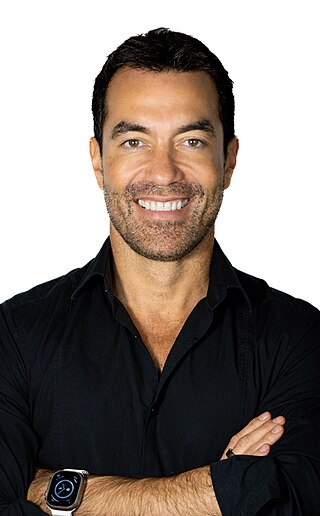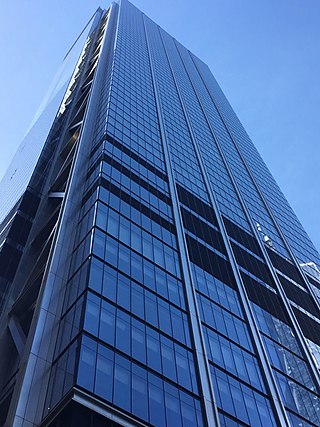Saatchi and Saatchi is a British multinational communications and advertising agency network with 114 offices in 76 countries and over 6,500 staff. It was founded in 1970 and is currently headquartered in London. The parent company of the agency group was known as Saatchi and Saatchi PLC from 1976 to 1994, was listed on the New York Stock Exchange until 2000 and, for a time, was a constituent of the FTSE 100 Index. In 2000, the group was acquired by the Publicis Groupe. In 2005, the group went private.
WPP plc is a British multinational communications, advertising, public relations, technology, and commerce holding company headquartered in London, England. It is the world's largest advertising company, as of 2023. WPP plc owns many companies, which include advertising, public relations, media, and market research networks such as AKQA, BCW, CMI Media Group, Essence Global, Finsbury, Grey, Hill & Knowlton, Mindshare, Ogilvy, Wavemaker, and VML. It is one of the "Big Four" agency companies, alongside Publicis, The Interpublic Group of Companies, and Omnicom Group. WPP has a primary listing on the London Stock Exchange, and is a constituent of the FTSE 100 Index.
An online advertising network or ad network is a company that connects advertisers to websites that want to host advertisements. The key function of an ad network is an aggregation of ad supply from publishers and matching it with the advertiser's demand. The phrase "ad network" by itself is media-neutral in the sense that there can be a "Television Ad Network" or a "Print Ad Network", but is increasingly used to mean "online ad network" as the effect of aggregation of publisher ad space and sale to advertisers is most commonly seen in the online space. The fundamental difference between traditional media ad networks and online ad networks is that online ad networks use a central ad server to deliver advertisements to consumers, which enables targeting, tracking and reporting of impressions in ways not possible with analog media alternatives.
Online advertising, also known as online marketing, Internet advertising, digital advertising or web advertising, is a form of marketing and advertising that uses the Internet to promote products and services to audiences and platform users. Online advertising includes email marketing, search engine marketing (SEM), social media marketing, many types of display advertising, and mobile advertising. Advertisements are increasingly being delivered via automated software systems operating across multiple websites, media services and platforms, known as programmatic advertising.

Ogilvy is a New York City-based British advertising, marketing, and public relations agency. It was founded in 1850 by Edmund Mather as a London-based agency. In 1964, the firm became known as Ogilvy & Mather after merging with a New York City agency that was founded in 1948 by David Ogilvy.

Sir Martin Stuart Sorrell is a British businessman and the founder of WPP plc, the world's largest advertising and PR group, both by revenue and the number of staff. Upon being ousted in April 2018 following an investigation by WPP's board into personal conduct and use of company money, Sorrell was the longest-serving chief executive of a FTSE 100 company.

Chris Ingram is a British businessman, entrepreneur and art collector with strong benevolent links to Woking.
J. Walter Thompson (JWT) was an advertisement holding company incorporated in 1896 by American advertising pioneer James Walter Thompson. The company was acquired in 1987 by multinational holding company WPP plc, and in November 2018, WPP merged J. Walter Thompson with fellow agency Wunderman to form Wunderman Thompson. In October 2023, WPP announced yet another merger in which Wunderman Thompson, along with another group agency VMLY&R, would cease to exist and create a new combined entity named VML. This took effect on January 1, 2024.
Grey Group is a global advertising and marketing agency with headquarters in New York City, and 432 offices in 96 countries, operating in 154 cities. It is organized into four geographical units: North America; Europe, Middle East and Africa, Asia-Pacific, and Latin America.
Say Media is a technology and advertising firm. The company provides a publishing platform (Tempest) to professional publishers and sells advertising across that platform and extended network of sites. Say Media has offices in San Francisco, Portland, NY, London, Montreal, Toronto, Chicago, and Detroit and is privately held.
Media buying refers to the procurement of advertising on mediums such as a television, newspapers, commercial radio, magazines, websites, mobile apps, over-the-top media services, out-of-home advertising etc. It also includes price negotiation and the appropriate placement of ads based on research to reach the right audiences considering the product, service and message being advertised. A media buyer is tasked to perform such activities.

Eric Austin Litman is an American entrepreneur and angel investor, and currently serves as CEO of the robotics health technology company, Aescape, inc. Litman co-founded Proxicom, built Viaduct from a one-man shop through a merger with the Wolf Group, and was the founder and CEO of Medialets, a mobile ad serving and advertising analytics company acquired by WPP plc.
24/7 Media, formerly 24/7 Real Media is a technology company headquartered in New York City and 20 offices in 12 countries, specializing in Digital Marketing. It provides for publishers, advertisers and agencies globally. It was formerly listed as "TFSM" on the NASDAQ stock exchange. The company was purchased by WPP plc in 2007 for $649 million. David J. Moore is the chairman, founder and CEO. He also served as chairman of the Interactive Advertising Bureau. In December, 2013, 24/7 Media announced it would merge with GroupM subsidiary, Xaxis.
Mixpo is an advertising software company, which provides software that allows companies and agencies to execute multi-screen video advertisement campaigns. The company’s services include software that allows clients to create online video ads and VideoVerify, a tool meant to identify fraudulent web publishers who inflate online ad numbers through the use of bots.
TubeMogul is an enterprise software company for brand advertising.
PubMatic, Inc. develops and implements online advertising software and strategies for the digital publishing and advertising industry. PubMatic's sell-side, real-time programmatic ad transaction advertising software puts publishers of websites, videos, and mobile apps into contact with ad buyers by using automated systems, while allowing users to opt-out of having their personal information collected on internet searches. PubMatic has a number of offices in countries around the world.
Nick Grouf is an American entrepreneur, investor, and philanthropist. Described as a "pioneer of the Web 1.0 generation", Grouf is the co-founder and managing director of Alpha Edison, a venture capital fund, and the founder of Clementine Capital, LLC, a technology-focused incubator.
The advertising industry is the global industry of public relations and marketing companies, media services, and advertising agencies. Several large advertising agencies, including WPP plc, Omnicom, Publicis Groupe, Interpublic and Dentsu, are among the industry's largest. It is a global, multibillion-dollar business that connects manufacturers and consumers. The industry ranges from nonprofit organizations to Fortune 500 companies.
Preston Martin Charles Rabl is a British investment banker, stockbroker and co-founder, with Martin Sorrell, of WPP, the world's largest advertising company.

GroupM is a U.S. based media investment group of the multinational Holding company WPP plc. GroupM is the world's largest media buying agency, as of 2023.





